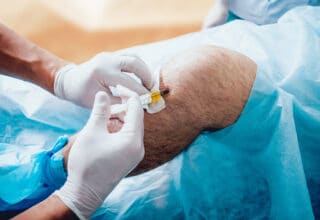
Synergy Spine and Pain Center
12150 Annapolis Road
Suite #209
Glenn Dale, MD 20769
Synergy Spine and Pain Center
10709 Indian Head Hwy MD-210
Suite D
Fort Washington, MD 20744
Synergy Spine and Pain Center
11233 Lockwood Drive
Silver Spring, MD 20901

More Pain Management & Rehabilitation Articles
PRP Injections Treat a Variety Of Pain

Platelet-rich plasma (PRP) is a concentrate of plasma that has a higher amount of growth factors. It is used to help regenerate soft tissue and healing. Platelet-rich plasma can treat sports injuries, including torn ligaments and tendons, skeletal fractures, strained muscles, sprained knees and chronic tendon injuries.
Blood is drawn from the patient and centrifuged to separate the platelet rich plasma. A local anesthetic may also be included with the platelet-rich plasma to be injected into the affected area or the joint.
The entire process usually takes about one hour. Pain at the injection site may increase after the procedure, but it declines in a few days. The patient may not feel the full benefits of the treatment until after a few weeks.
Risks and Side Effects
There are general risks of skin puncture associated with contamination and infection. However, since a PRP injection is made with the patient’s own blood, the risk of these complications is very low.
The most common side effect of the procedure is tenderness at the site of the injection. Hence, the patient should minimize activity for at least one day following the procedure.
Other Articles You May Find of Interest...
- Alleviating Joint Pain in Pets: A Comprehensive Guide
- Sciatica Treatment Options
- How to Promote Bone Fracture Healing? Tips for Faster Healing
- Managing Chronic Back and Neck Pain
- Pervasiveness Of Pain
- Effective Solutions for Lower Back Arthritis: Medial Branch Blocks and Radiofrequency Ablation
- Spinal Compression Fracture Treatment Options

















